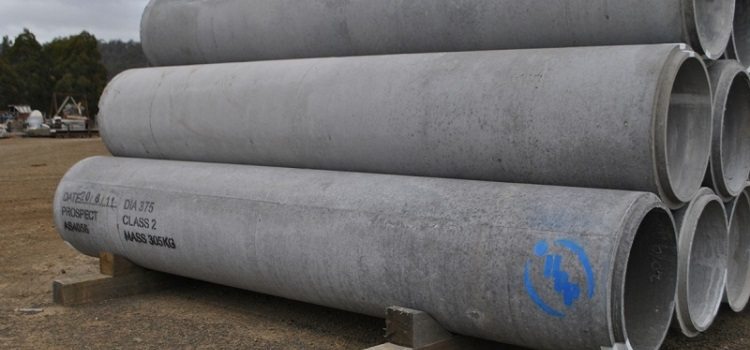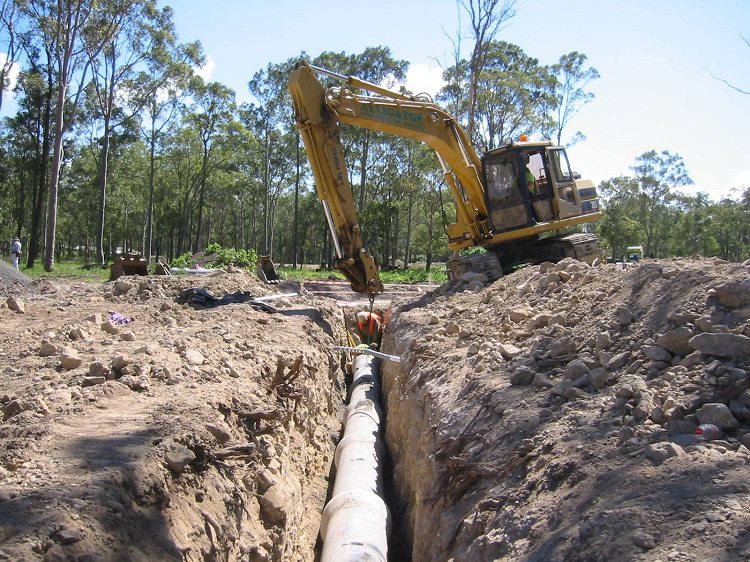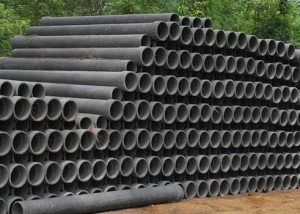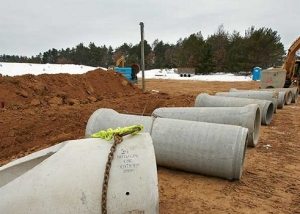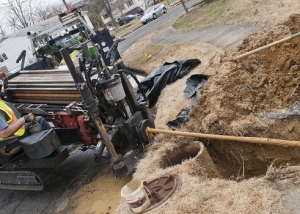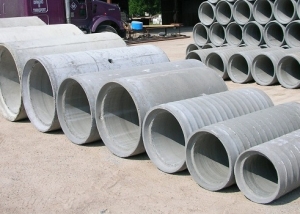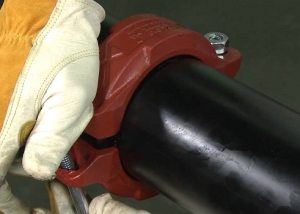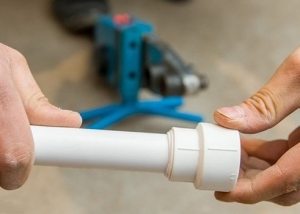Asbestos-cement pipe is used for laying pipelines for various purposes. This is possible due to high strength, low heat conductivity and long service life and reasonable price of products. Asbestos is a thin-fiber material belonging to the class of silicates. In addition to 15 percent of asbestos, it includes cement (about 85%) and water. Allocate pressureless asbestos-cement pipes and pressureless.
Content
Pressure pipe parameters
Asbestos-cement products related to non-pressure type are produced according to the quality standard and have the following characteristics presented in the table.
Table 1
| Main characteristics | Nominal bore * 10 mm | unit of measurement | |||||
| 10 | 15 | 20 | 30 | 40 | 50 | ||
| Length | 39,5 | 39,5 | 50,0 | * 10² mm | |||
| Outside diameter | 11,8 | 16,1 | 21,5 | 30,9 | 40,3 | 50,8 | * 10 mm |
| Diameter inside | 10,0 | 14,1 | 18,9 | 27,7 | 36,5 | 45,6 | * 10 mm |
| Wall thickness | 90 | 100 | 130 | 160 | 190 | 260 | * 10-1 mm |
| Hydraulic pressure test | 400 | 400 | 400 | 400 | 400 | 400 | kPa |
| Crush load value | 46 | 40 | 32 | 42 | 50 | 60 | not less than * 10 kgf |
| Value bending load |
18,0 | 40,0 | — | — | — | — | not less than * 10 kgf |
| Mass meter asbestos-cement pipe | 61 | 94 | 180 | 322 | 501 | 860 | *10-1 kg |
The normative document for non-pressure type asbestos-cement pipes is GOST 1839 from 1980.
Asbestos-free pressure-free products: use
Asbestos-cement pipes are most often used for laying a pressureless sewer network in those places where a pressure sewage system is technically impossible. In this case, the construction of sewers will be much cheaper. Also, asbestos pipes cut into rings can be a good option for a viewing well, which has a shallow depth.
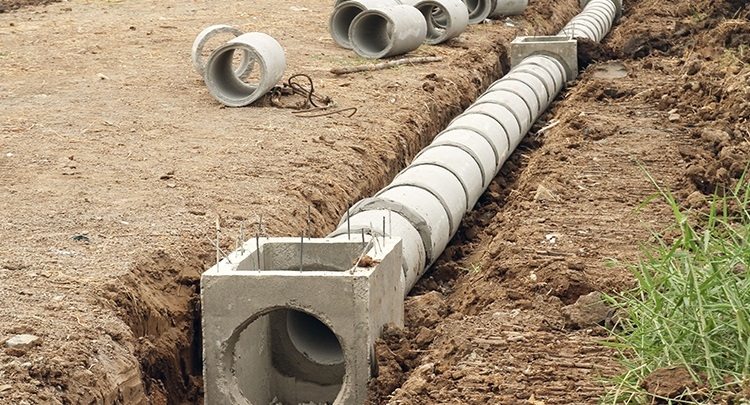
Pressureless pipes made of asbestos cement are used for sewage systems in which waste water moves by gravity
When installing asbestos-cement pipes for garbage chutes and sewer networks, there is no pollution of the soil, the environment, since the material is resistant to microorganisms.
Note! Non-pressure products eliminate the risk of soil infection through them during long-term stagnation of sewage or shutting down the pipeline if necessary.
Due to the low electrical conductivity, asbestos-cement pipes can be used for laying electric cables and telephone communications. Non-pressure products of this type are not susceptible to electrochemical corrosion, which occurs when exposed to stray currents.
In addition, due to their technical characteristics, asbestos-cement pipes have proven themselves well in thermal, water and drinking systems. Non-pressure products are also suitable for storm sewers, chimneys and ventilation.
Pressure pipe: technical parameters
Asbestos cement pressure pipe and its production must comply with all points of GOST 539 from 1980. This standard also applies to couplings and divides products into 4 classes.
table 2
| Pipe class | Operating pressure | |
| * 10 kgf / cm² | kPa | |
| VT15 (coupling SAM15) | 1,5 | 1500 |
| VT12 (coupling SAM12) | 1,2 | 1200 |
| VT9 (coupling SAM9) | 0,9 | 900 |
| VT6 (coupling SAM6) | 0,6 | 600 |
Working pressure is the maximum value of hydraulic pressure at which a pipe of one class or another can be used. Choosing the right class depends on the operating conditions.
Asbestos-cement pipes of pressure type must not have delamination, breaks or cracks. Their ends require turning. For products whose length is 2950 and 3950 millimeters, the deviation from straightness cannot exceed 12 mm; 5 thousand mm - 18 mm; 5 thousand 950 mm - 24 mm. An important parameter of such pipes should be waterproof.
Types of pressure pipes
The throughput and length of the product determines its classification as one of three types. Type 1 pressure pipe must have the parameters shown in the table.
Table 3
| Conditional pass, * 10² mm |
Length of the product, * 10³ mm |
Outside diameter * 10² mm |
Inside diameter, * 10² mm / wall thickness, * 10 mm |
||
| for VT6 | for VT9 | for VT12 | |||
| 1 | 2.95 and 3.95 | 1,22 | 1,04/0,90 | 1,00/1,10 | 0,96/1,3 |
| 1,50 | 2.95 and 3.95 | 1,68 | 1,46/1,10 | 1,41/1,35 | 1,35/1,65 |
| 2 | 3,95 | 2,24 | 1,96/1,4 | 1,89/1,750 | 1,81/2,15 |
| 2,5 | 3,95 | 2,74 | 2,44/1,5 | 2,35/1,95 | 2,28/2,3 |
| 3,0 | 3,95 | 3,24 | 2,89/1,750 | 2,79/2,25 | 2,70/2,7 |
| 3,5 | 3,95 | 3,73 | 3,34/1,95 | 3,22/2,55 | 3,12/3,05 |
| 4 | 3,95 | 4,27 | 3,81/2,3 | 3,68/2,95 | 3,56/3,55 |
| 5 | 3,95 | 5,28 | 4,73/2,75 | 4,56/3,60 | 4,41/4,35 |
Type 2 pressure pipe must have the parameters shown in the table.
Table 4
| Nominal bore * 10² mm | Product length, * 10³ mm | Outside diameter, * 10² mm | Inside diameter, * 10² mm / wall thickness, * 10 mm | |||
| for VT6 | for VT9 | for VT12 | for VT15 | |||
| 2,0 | 5 | 2,24 | 2,00/1,20 | 1,96/1,4 | 1,88/1,8 | 1,80/2,2 |
| 2,5 | 5 | 2,74 | 2,48/1,3 | 2,42/1,6 | 2,34/2,0 | 2,26/2,40 |
| 3 | 5 | 3,24 | 2,92/1,6 | 2,86/1,9 | 2,76/2,4 | 2,67/2,85 |
| 3,50 | 5 | 3,73 | 3,37/1,8 | 3,29/2,2 | 3,17/2,8 | 3,07/3,3 |
| 4 | 5 | 4,27 | 3,85/2,10 | 3,77/2,5 | 3,63/3,2 | 3,52/3,75 |
| 5 | 5 | 5,28 | 4,76/2,6 | 4,66/3,10 | 4,50/3,9 | 4,36/4,6 |
Pressure pipe type 3 must have the parameters presented in the table.
Table 5
| Nominal bore * 10² mm | Product length, * 10³ mm | Outside diameter, * 10² mm | Inside diameter, * 10² mm / wall thickness, * 10 mm | |||
| for VT6 | for VT9 | for VT12 | for VT15 | |||
| 2 | 5,95 | 2,24 | 1,96/14 | 1,89/1,75 | 1,81/2,15 | 1,76/2,40 |
| 3 | 5,95 | 3,24 | 2,89/1,750 | 2,79/2,25 | 2,70/2,7 | 2,56/3,4 |
Use of pressure pipes
Asbestos pressure type pipes have a fairly wide range of applications. So, they are suitable for laying networks of drinking, industrial water, as well as plumbing, irrigation and drainage systems. Asbestos-cement pipes can be equipped with ventilation, chimneys, drainage collectors. They are applicable as garage ceilings, casing elements for wells and wells, poles for the fence.
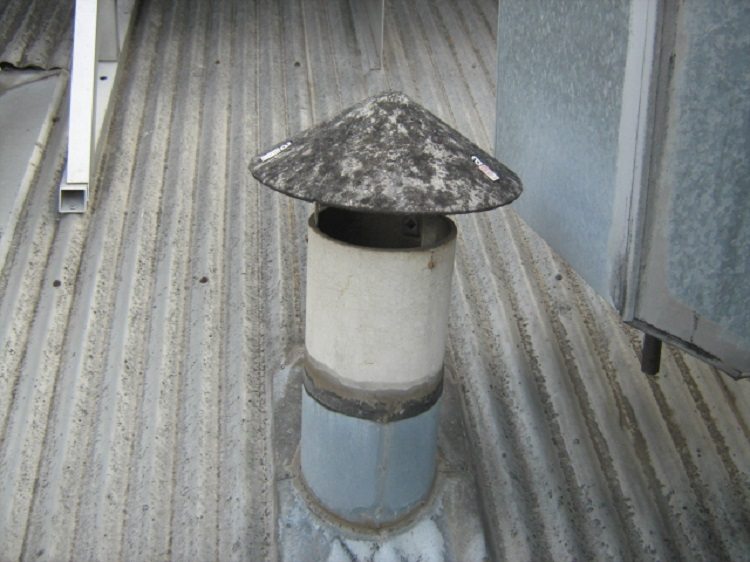
Pressure pipes made of asbestos cement can withstand high temperatures, so they are often used as chimneys
Note! Such a variety of areas of use is explained by low thermal conductivity, resistance to chemical attack, corrosion, lack of decay and ease of installation.
Asbestos-cement pipes can be used in heating mains, providing the system with high reliability at coolant temperatures up to 130 degrees. However, along with the many advantages of such products, it should be noted that both pressure and non-pressure products do not withstand mechanical effects. In this regard, during installation, care must be taken and accuracy.
Features of laying asbestos-cement pipes
The depth of the water pipes is selected based on the temperature of the water, the mode of its supply and the freezing point of the soil. If it is necessary to lay the pipeline along a curved path using couplings on rubber seals, it is allowed to connect asbestos-cement pipes at an angle of no more than 3º for every 5 meters.
If laying is carried out along a fairly gentle curve, the gap between the ends of adjacent products should be at least 0.15-0.20 (* 10) cm. Asbestos pipes are used in both dry and water-saturated soils. In the latter case, it is necessary to carry out associated drainage.
When laying such products, it is unacceptable to align the bottom of the trench by placing trimmed boards or stones under their end points. Asbestos-cement pipes, which are placed in the trench, should extend along their bottom not less than ¼ of their circumference each. Rubber o-rings during installation in conditions of low air temperatures should not be used in a frozen condition.
When there is a break in laying, the ends of the couplings and pipes, the openings in the valves and other fittings are closed with plugs.
How are asbestos-cement pipes connected
Between each other products are joined by means of asbestos-cement couplings.Pressure pipes (asbestos-cement) are connected by couplings having two grooves for the sealing rubber rings. These grooves are pre-cleaned of contaminants and rings are placed in them. It is important to straighten the sealing elements so that they evenly protrude from the grooves.
Note! The recesses located in the body of the o-rings should contact the center of the asbestos-cement sleeve.
To facilitate the pulling of the connecting element on the pipe, lubrication of the outer surface of the ends of the product with a soap solution or paste containing 15% water, 40% graphite and 45% glycerin will help.
The pulling operation is performed by a special device until the structure is lowered into the trench. The order is as follows: a pipe with two couplings at the ends drops to the bottom of the trench, then a product without couplings falls, then again a pipe with two tensioned couplings, etc.
Asbestos cement pipes have good technical parameters that allow their use in many fields. Their advantages and affordable prices explain the continued demand for such products.
